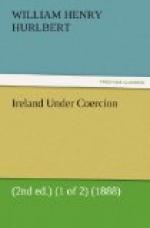history, before the great year of famine, 1847, the
Irish emigrations which followed the wars against the
woollen industries in the seventeenth century, and
the linen industries in the eighteenth. A staunch,
doggedly Protestant people, loving the New England
Puritans and the Anglicans of Eastern Virginia little
better than the Maryland Catholics, but contributing
more than their full share of traditional antipathy
to that extreme dislike and dread of the Roman Church
which showed itself half-a-century ago in the burning
of convents, and thirty years ago gave life and fire
to the Know-Nothing movement. Even so late as
at the time of Father Burke’s grand and most
successful mission to America, I remember how much
astonished and impressed he was by the vigour and
the virulence of these feelings. One of the bishops,
he told me, in a great diocese tried (though of course
in vain) to dissuade him on this account from wearing
his Dominican dress. These anti-Catholic passions
are much stronger in America to-day than it always
suits our politicians to remember, though to forget
it may some day be found very dangerous. Even
now two of the ablest prelates of the most liberal
of the Protestant American bodies, Bishop Cleveland
Coxe of Western New York, and Bishop Beckwith of Georgia,
the latter of whom I met the other day in Rome on
his return from Palestine, are promoting what looks
very much like a crusade against the plan for establishing
a Catholic University at Washington. Bishop Cleveland
Coxe’s denunciations of what he calls “the
alien Church,” point straight to a revival of
the “Native American” movement; and I fear
that President Cleveland’s gift of a copy of
the Constitution to Leo XIII. will hardly make American
Catholics forget either the hereditary anti-Catholic
feeling which led him, when Governor of New York, to
imperil the success of the Democratic party by his
dogged resistance to the Catholic demand for the endowment
of Catholic schools and protectories, or the scandalous
persecution (it can be called by no other name) of
Catholics in Alaska, which was carried on in the name
and under the patronage of his sister, Miss Cleveland,
by a local missionary of the Presbyterian Church,
to the point of the removal by the President of a
Federal judge, who dared to award a Catholic native
woman from Vancouver the custody of her own child.
It is hard to imagine a greater misfortune for the
Church in Ireland, and for both the Church and the
Irish race in America, than the identification of
the Home Rule movement with the Church, and its triumph,
after being so identified, and with the help of British
sympathisers and professional politicians, over the
resistance of Protestant Ireland. This dilemma
of the Church in Ireland, plainly seen at Rome, as
I know, to-day, was forcibly presented in the speech
of Colonel Saunderson.
The chair at this Loyalist meeting was filled by the
Provost of Trinity, Dr. Jellett, a man of winning
and venerable aspect, a kind of “angelic doctor,”
indeed, whose musical and slightly tremulous voice
gave a singular pathos and interest to his brief but
very earnest speech.[11]




